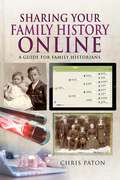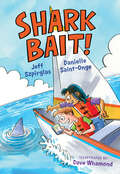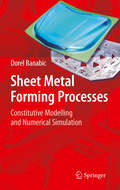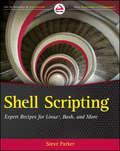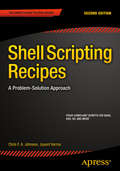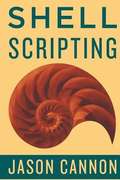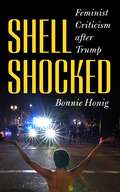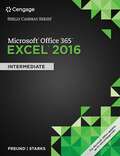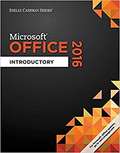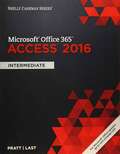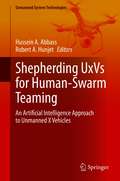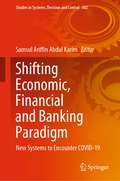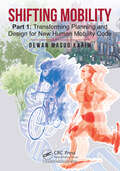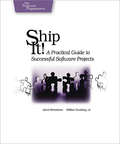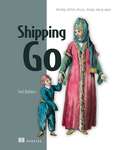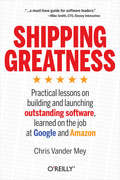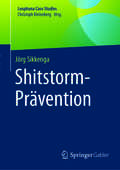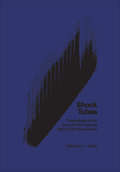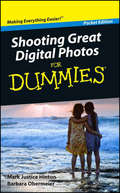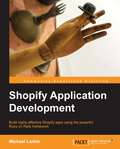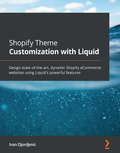- Table View
- List View
Sharing Your Family History Online: A Guide for Family Historians (Tracing Your Ancestors)
by Chris PatonAn expert genealogist explains how to share your family history online and collaborate with distant relatives to build a richer ancestral story.For many enthusiasts pursuing their family history research, the online world offers a seemingly endless archive of digitized materials. In addition to hosting records, however, the internet also offers a unique platform on which we can host our research and potentially connect with distant relatives from around the world.In Sharing Your Family History Online, genealogist Chris Paton demonstrates the many ways we can present our research and encourage collaboration online. He details helpful organizations and social media applications, describes the software platforms on which we can collate our stories, and illustrates the variety of ways we can publish our stories online.Along the way, Paton also explores how we can make our research work for us, by connecting with experts and relatives who can help solve ancestral mysteries. This happens not only by sharing stories, but by accessing uniquely held documentation by family members around the world, including our shared DNA.
Shark Bait! (Orca Echoes)
by Danielle Saint-Onge Jeff SzpirglasKey Selling Points A young girl is consumed by tracking a great white shark and uses technology and her knowledge to educate the adults around her. This is a humorous story that has underlying themes of science, technology, environmental awareness and water safety. This story was inspired by a real shark named Hilton, who was being tracked in the waters off the coast of Nova Scotia by the data-centered organization OCEARCH. The author’s book Something's Fishy (2011), which also had a protagonist who was fascinated by sharks, was nominated for the Shining Willow Award and was a CCBC Best Book. Features fifteen black-and white-illustrations.
She Memes Well: Essays
by Quinta Brunson&“In She Memes Well, Quinta gives more than a peek behind the curtain. She invites us in, lets us poke around and offers a balm for our aching souls. She moves beyond the jokes into something much deeper, something we may not recognize we need. She is the friend, sister, lover, cool co-worker we all wished we had.&”—Gabrielle Union, actress and New York Times bestselling author of We&’re Going to Need More Wine From comedian Quinta Brunson comes a deeply personal and funny collection of essays about trying to make it when you're struggling, the importance of staying true to your roots, and how she's redefined humor online. Quinta Brunson is a master at breaking the internet. Before having any traditional background in media, her humorous videos were the first to go viral on Instagram&’s platform. From there, Brunson&’s wryly observant POV helped cement her status in the comedy world at large, with roles on HBO, Netflix, ABC, Adult Swim, BuzzFeed, the CW, and Comedy Central. Now, Brunson is bringing her comedic chops to the page in She Memes Well, an earnest, laugh-out-loud collection about this unusual road to notoriety. In her debut essay collection, Quinta applies her trademark humor and heart to discuss what it was like to go from a girl who loved the World Wide Web to a girl whose face launched a thousand memes. With anecdotes that range from the ridiculous—like the time she decided to go clubbing wearing an outfit she describes as "Gary Coleman meets metrosexual pirate"—to more heartfelt material about her struggles with depression, Quinta's voice is entirely authentic and eminently readable. With its intimate tone and hilarious moments, She Memes Well will make you feel as if you're sitting down with your chillest, funniest friend.
Sheet Metal Forming Processes
by Dorel BanabicThe book gives a synthetic presentation of the research performed in the field of sheet metal forming simulation during more than twenty years by the members of three teams: the Research Centre on Sheet Metal Forming - CERTETA (Technical University of Cluj-Napoca, Romania); AUTOFORM software-house company from Zürich, Switzerland and VOLVO automotive company from Sweden. The first chapter reminds some fundamental topics of the theory of plasticity. A more extended chapter is devoted to the presentation of the phenomenological yield criteria, emphasizing the formulations proposed by the CERTETA team (BBC models). The sheet metal formability is discussed in a separate chapter. After presenting the methods used for the formability assessment, the discussion focuses on the forming limit curves. In this context, the authors emphasize their contributions to the mathematical modeling of forming limit curves. The aspects related to the implementation of the constitutive models in finite-element codes are discussed in the last chapter of the book. The performances of the models are proved by the numerical simulation of various sheet metal forming processes: hydroforming, deep-drawing and forming of the complex parts. The book is useful for the students, doctoral fellows, researchers and engineers who are mainly interested in the mechanical modeling and numerical simulation of sheet metal forming processes. Modeling and numerical simulation of sheet metal forming processes.
Shell Scripting
by Steve ParkerA compendium of shell scripting recipes that can immediately be used, adjusted, and applied The shell is the primary way of communicating with the Unix and Linux systems, providing a direct way to program by automating simple-to-intermediate tasks. With this book, Linux expert Steve Parker shares a collection of shell scripting recipes that can be used as is or easily modified for a variety of environments or situations. The book covers shell programming, with a focus on Linux and the Bash shell; it provides credible, real-world relevance, as well as providing the flexible tools to get started immediately. Shares a collection of helpful shell scripting recipes that can immediately be used for various of real-world challenges Features recipes for system tools, shell features, and systems administration Provides a host of plug and play recipes for to immediately apply and easily modify so the wheel doesn't have to be reinvented with each challenge faced Come out of your shell and dive into this collection of tried and tested shell scripting recipes that you can start using right away!
Shell Scripting Recipes
by Jayant Varma Chris F. A. JohnsonShell Scripting Recipes is filled with over 150 much-needed and practical recipes that follow a problem-solution format, and help all Unix users regain some of the lost time spent creating and testing shell scripts. Most scripts in this book are POSIX (Portable Operating System Interface)-compliant, so they are supported by many of the major shell variants, including Bash, ksh, and sh, among others. This completely updated second edition takes into account the many changes to shell scripting that have occurred since its original publication nearly ten years ago, and all the recipes are now relevant for a modern audience. Each real-world example recipe follows the same structure and easily shows you what's going on in each case. File conversion (DOS, UNIX, and Mac), system administration, and resource monitoring are just a few of the topics covered in this highly practical shell scripting reference. You will also find recipes for filename management, complex date calculations, screen control capabilities, and more. Authors Chris Johnson's and Jayant Varma's code is clear, direct, and applicable, and he explains everything well in each recipe so that you understand not just how to do something, but why to do it that way. Shell Scripting Recipes is an invaluable book and one to add to your library today. What you'll learn How to effectively use the POSIX shell and command-line utilities How to use strings, numbers, words, and filenames with ease Effective file management and file conversion (DOS, UNIX, and Mac) How to monitor resources effectively How to perform complex date calculations Manage a POP3 email server Who this book is for This book is for anyone who has the basic knowledge of what shell scripting is and wants to learn how to use it properly. Each recipes is explained clearly and the book begins with the simplest recipes, so all you need is a basic knowledge of what shell scripting is. Table of Contents 1: The POSIX Shell and Command-Line Utilities 2: Playing with Files: Viewing, Manipulating, and Editing Text Files 3: String Briefs 4: What's in a Word? 5: Scripting by Numbers 6: Loose Names Sink Scripts: Bringing Sanity to Filenames 7: Treading a Righteous PATH 8: The Dating Game 9: Good Housekeeping: Monitoring and Tidying Up File Systems 10: Screenplay: The screen-funcs Library 11: Aging, Archiving, and Deleting Files 12: Covering All Your Databases 13: Home on the Web 14:Taking Care of Business 15: Random Acts of Scripting 16: A Smorgasbord of Scripts 17: Script Development Management Appendix: Internet Scripting Resources
Shell Scripting: How to Automate Command Line Tasks Using Bash Scripting and Shell Programming
by Jaosn Cannon<p>If you want to learn how to write shell scripts like a pro, solve real-world problems, or automate repetitive and complex tasks, read on. <p>Hello. My name is Jason Cannon and I'm the author of Linux for Beginners, Python Programming for Beginners, and an instructor to thousands of satisfied students. I started my IT career in the late 1990's as a Unix and Linux System Engineer and I'll be sharing my real-world shell scripting and bash programming experience with you throughout this book. <p>By the end of this book you will be able to create shell scripts with ease. You'll learn how to take tedious and repetitive tasks and turn them into programs that will save you time and simplify your life on Linux, Unix, or MAC systems.</p>
Shell-Shocked: Feminist Criticism after Trump
by Bonnie HonigA biting, funny, up-to-the-minute collection of essays by a major political thinker that gets to the heart of what feminist criticism can do in the face of everyday politics.Stormy Daniels offered a #metoo moment, and Anderson Cooper missed it. Conservatives don’t believe that gender is fluid, except when they’re feminizing James Comey. “Gaslighting” is our word for male domination but a gaslight also lights the way for a woman’s survival.Across two dozen trenchant, witty reflections, Bonnie Honig offers a biting feminist account of politics since Trump. In today’s shock politics, Honig traces the continuing work of patriarchy, as powerful, mediocre men gaslight their way across the landscape of democratic institutions.But amid the plundering and patriarchy, feminist criticism finds ways to demand justice. Shell-Shocked shows how women have talked back, acted out, and built anew, exposing the practices and policies of feminization that have historically been aimed not just at women but also at racial and ethnic minorities. The task of feminist criticism—and this is what makes it particularly well-suited to this moment—is to respond to shock politics by resensitizing us to its injustices and honing the empathy needed for living with others in the world as equals. Feminist criticism’s penchant for the particular and the idiosyncratic is part of its power. It is drawn to the loose threads of psychological and collective life, not to the well-worn fabrics with which communities and nations hide their shortcomings and deflect critical scrutiny of their injustices. Taking literary models such as Homer’s Penelope and Toni Morrison’s Cee, Honig draws out the loose threads from the fabric of shock politics’ domination and begins unraveling them. Honig’s damning, funny, and razor sharp essays take on popular culture, national politics, and political theory alike as texts for resensitizing through a feminist lens. Here are insightful readings of film and television, from Gaslight to Bombshell, Unbelievable to Stranger Things, Rambo to the Kavanaugh hearings. In seeking out the details that might break the spell of shock, this groundbreaking book illustrates alternative ways of living and writing in a time of public violence, plunder, and—hopefully—democratic renewal.
Shelly Cashman Series Microsoft Office 365 & Excel 2016: Intermediate
by Joy L. Starks Steven M. Freund Eric SchmiederDiscover the latest advancements in Microsoft Excel 2016 with MICROSOFT OFFICE 365 & EXCEL 2016: INTERMEDIATE -- the new edition in today’s generation of acclaimed Shelly Cashman Series books. For more than three decades, the Shelly Cashman Series has effectively introduced computer skills to millions. MICROSOFT OFFICE 365 & EXCEL 2016: INTERMEDIATE continues the Series’ strong history of innovation with a proven learning approach enhanced to address the learning styles of students like you. A trademark step-by-step, screen-by-screen approach encourages you to expand your understanding of Microsoft Excel 2016 through experimentation, critical thought, and personalization. This new edition delivers effective educational materials specifically designed to engage, improve retention, and prepare you for future success in working with both basic and more advanced Microsoft Excel 2106 skills.
Shelly Cashman Series Microsoft Office 365 And Office 2016: Introductory
by Steven M. Freund Corinne Hoisington Mary Z. Last Misty E Vermaat Eric SchmiederDiscover how to maximize the advantages that the latest version of Microsoft Office offers with the focused approach found in MICROSOFT OFFICE 365 & OFFICE 2016: INTRODUCTORY. This new softcover, spiral-bound edition is part of the acclaimed Shelly Cashman Series that has effectively introduced computer skills to millions of students like you. MICROSOFT OFFICE 365 & OFFICE 2016: INTRODUCTORY continues the Series� strong history of innovation with an enhanced learning approach to address your needs, no matter what your learning style. A trademark step-by-step, screen-by-screen approach encourages you to expand your understanding of Microsoft Office 2016 through experimentation, critical thought, and personalization. This new edition delivers the most effective educational materials specifically designed to engage, improve retention, and prepare you for success.
Shelly Cashman Series Office 365 And Access 2016: Intermediate
by Mary Z. Last Philip J. PrattDiscover the latest advancements in Microsoft Access 2016 with MICROSOFT OFFICE 365 & ACCESS 2016: INTERMEDIATE -- the new edition in todays generation of acclaimed Shelly Cashman Series books. For more than three decades, the Shelly Cashman Series has effectively introduced computer skills to millions. MICROSOFT OFFICE 365 & ACCESS 2016: INTERMEDIATE continues the Series strong history of innovation with a proven learning approach enhanced to address the learning styles of students like you. A trademark step-by-step, screen-by-screen approach encourages you to expand your understanding of Microsoft Access 2016 through experimentation, critical thought, and personalization. This new edition delivers effective educational materials specifically designed to engage, improve retention, and prepare you for future success in working with both basic and more advanced Microsoft Access 2016 skills.
Shepherding UxVs for Human-Swarm Teaming: An Artificial Intelligence Approach to Unmanned X Vehicles (Unmanned System Technologies)
by Hussein A. Abbass Robert A. HunjetThis book draws inspiration from natural shepherding, whereby a farmer utilizes sheepdogs to herd sheep, to inspire a scalable and inherently human friendly approach to swarm control. The book discusses advanced artificial intelligence (AI) approaches needed to design smart robotic shepherding agents capable of controlling biological swarms or robotic swarms of unmanned vehicles. These smart shepherding agents are described with the techniques applicable to the control of Unmanned X Vehicles (UxVs) including air (unmanned aerial vehicles or UAVs), ground (unmanned ground vehicles or UGVs), underwater (unmanned underwater vehicles or UUVs), and on the surface of water (unmanned surface vehicles or USVs). This book proposes how smart ‘shepherds’ could be designed and used to guide a swarm of UxVs to achieve a goal while ameliorating typical communication bandwidth issues that arise in the control of multi agent systems. The book covers a wide range of topics ranging from the design of deep reinforcement learning models for shepherding a swarm, transparency in swarm guidance, and ontology-guided learning, to the design of smart swarm guidance methods for shepherding with UGVs and UAVs. The book extends the discussion to human-swarm teaming by looking into the real-time analysis of human data during human-swarm interaction, the concept of trust for human-swarm teaming, and the design of activity recognition systems for shepherding.Presents a comprehensive look at human-swarm teaming;Tackles artificial intelligence techniques for swarm guidance;Provides artificial intelligence techniques for real-time human performance analysis.
Shifting Economic, Financial and Banking Paradigm: New Systems to Encounter COVID-19 (Studies in Systems, Decision and Control #382)
by Samsul Ariffin Abdul KarimThis book presents the main ideas on shifting the economy, finance, and banking sectors among ASEAN countries into a new paradigm. Since the economy and finance, as well as the banking sector in the ASEAN region, have been growing years by years, there is the need for the policymakers and relevant agencies to study the ideas on shifting the ASEAN economy, finance, and banking towards globalization through a new paradigm. Furthermore, the recent COVID-19 pandemic has affected not just human lives but also the economic and financial sectors. Because of COVID-19, most countries around the world have imposed lockdown and moving control order (MCO) as well as conditionally moving control order (CMCO). In this book, we tackle the main ideas on shifting the economy, finance, and banking sectors among ASEAN countries into a new paradigm. The researchers used econometric, mathematics, statistics, and quantitative sciences to study many economic, finance, and banking issues such as cryptocurrency, consumer preferences, and good governance. This book presents various new and novel results, methods, and algorithms. The findings of this book shall benefit the ASEAN policymakers, investors, and other relevant agencies. This book is also suitable for postgraduate students, researchers, and other scientists who work in econometric, finance, banking, and numerical simulation.
Shifting Mobility: Part 1: Transforming Planning and Design for New Human Mobility Code
by Dewan Masud KarimIn the face of resource depletion, environmental changes, lifestyle changes, demographic and digital adaptation, old ideologies of city building and expensive and complex automobility solutions are in freefall. These changes are creating severe friction between the old and new paradigms. This book provides new perspectives through the process of ideological disassociation and concepts of human mobility code. The basic premise of the book, human mobility is an essential component of our creativity that comes from our unconscious desire to become a part of a community. Several new concepts in the book starts with the hallmark of new discovery of human mobility code and its implications of urban mobility boundary systems to stay within safe planetary zone. A new discovery of human mobility code from comprehensive research finding prove that each individual develops a unique mobility footprint and become our mobility identity. Beyond individual hallmarks, human develops collective mobility codes through interaction with the third space on which entire mobility systems lie and are created by the fundamentals of city planning and the design process. Readers are introduced to an innovative mobility planning process and reinvention of multimodal mobility approaches based on new mobility code while formulating new concepts, practical solutions and implementation techniques, tools, policies, and processes to reinforce low-carbon mobility options while addressing social equity, environmental, and health benefits. Finally, the book arms us with knowledge to prevent the disaster of full technological enlightenment against our natural human mobility code.
Ship it!: A Practical Guide to Successful Software Projects (Pragmatic Programmers)
by Jared Richardson William A. GwaltneyShip It! is a collection of tips that show the tools andtechniques a successful project team has to use, and how to use themwell. You'll get quick, easy-to-follow advice on modernpractices: which to use, and when they should be applied. This bookavoids current fashion trends and marketing hype; instead, readersfind page after page of solid advice, all tried and tested in thereal world. Aimed at beginning to intermediate programmers, Ship It! will show you: Which tools help, and which don'tHow to keep a project movingApproaches to scheduling that workHow to build developers as well as productWhat's normal on a project, and what's notHow to manage managers, end-users and sponsorsDanger signs and how to fix them Few of the ideas presented here are controversial or extreme; most experiencedprogrammers will agree that this stuff works. Yet 50 to 70 percent of allproject teams in the U.S. aren't able to use even these simple, well-acceptedpractices effectively. This book will help you get started. Ship It! begins by introducing the common technicalinfrastructure that every project needs to get the job done. Readerscan choose from a variety of recommended technologies according totheir skills and budgets. The next sections outline the necessarysteps to get software out the door reliably, using well-accepted,easy-to-adopt, best-of-breed practices that really work. Finally, and most importantly, Ship It! presents commonproblems that teams face, then offers real-world advice on how tosolve them.
Shipping Go: Develop, deliver, discuss, design, and go again
by Joel HolmesBuild and upgrade an automated software delivery pipeline that supports containerization, integration testing, semantic versioning, automated deployment, and more.In Shipping Go you will learn how to: Develop better software based on feedback from customers Create a development pipeline that turns feedback into features Reduce bugs with pipeline automation that validates code before it is deployed Establish continuous testing for exceptional code quality Serverless, container-based, and server-based deployments Scale your deployment in a cost-effective way Deliver a culture of continuous improvement Shipping Go is a hands-on guide to shipping Go-based software. Author Joel Holmes shows you the easy way to set up development pipelines, fully illustrated with practical examples in the powerful Go language. You&’ll put continuous delivery and continuous integration into action, and discover instantly useful guidance on automating your team&’s build and reacting with agility to customer demands. Your new pipelines will ferry your projects through production and deployment, and also improve your testing, code quality, and production applications. Purchase of the print book includes a free eBook in PDF, Kindle, and ePub formats from Manning Publications. About the Technology An effective software delivery pipeline automates all stages, from initial design, through development, deployment, and ultimately the usage experience that feeds back into new features and releases. Go embraces the best practices of Continuous Delivery, and adds a few language-specific tools and twists of its own. About the Book Shipping Go shows you how to build Go-specific software development pipelines. You&’ll have a basic CI/CD process up and running by the time you finish Chapter 3, along with an iterative process for designing, releasing, and revising your applications. Then, you&’ll systematically upgrade your pipeline to support containerization, integration testing, semantic versioning, and automated deployment. A set of handy appendices help you translate these valuable practices to Kotlin, Python, and JavaScript applications. What&’s Inside Create a development pipeline that turns feedback into features Automatically validate code before it is deployed Serverless, container-based, and server-based deployments Scale your deployment in a cost-effective way About the Reader For Go developers. About the Author Joel Holmes builds cloud native applications, helping to architect, design, and develop them. A Golang tech lead, Aliénor Latour was the technical editor for this book. Table of Contents PART 1 - STARTUP 1 Delivering value 2 Introducing continuous integration 3 Introducing continuous testing 4 Introducing continuous deployment PART 2 - SCALING 5 Code quality enforcement 6 Testing frameworks, mocking, and dependencies 7 Containerized deployment PART 3 - GOING PUBLIC 8 Configuration management and stable releases 9 Integration testing 10 Advanced deployment 11 The loop
Shipping Greatness: Practical lessons on building and launching outstanding software, learned on the job at Google and Amazon
by Chris Vander MeyNeed a shortcut to a degree in shipping great software? Successful team leaders must have an extremely broad skill set to find the right product, work through a complex and ever-changing development process, and do it all incredibly quickly. In this guide, Chris Vander Mey provides a simplified, no-BS approach to the entire software lifecycle, distilled from lessons he learned as a manager at Amazon and Google.In the first part of the book, you’ll learn a step-by-step shipping process used by many of the best teams at Google and Amazon. Part II shows you the techniques, best practices, and skills you need to face an array of challenges in product, program, project, and engineering management.Clearly define your product and develop your mission and strategyAssemble your team and understand enough about systems to communicate with themCreate a beautiful, intuitive, and simple user experienceTrack your team’s deliverables and closely manage the testing processCommunicate clearly to gracefully handle requests, senior-management interactions, and feedback from various sourcesBuild metrics to track progress, spot problems, and celebrate successStick to your launch checklist and plan for marketing and PR
Shipwrecked!: An Unofficial Minecrafters Novel (Aquatic Adventures in the Overworld #5)
by Maggie MarksBrothers Mason and Asher discover an abandon shipwreck in the fifth Aquatic Adventures in the Overworld book! When Mason and Asher discover an abandoned shipwreck on the ocean floor, they begin to explore. Does the ship hold valuable loot? Maybe! But before they can claim any treasure for their own, they discover they&’re not alone. The shipwreck is home to two griefers. And now that the brothers have stumbled upon the ship, the griefers aren&’t about to let them go. Find out more in this heroic fifth book of Aquatic Adventures in the Overworld: Shipwrecked! Brothers Mason and Asher are learning how to cope with life outside the Overworld after a terrifying shipwreck that left them stranded underwater. Teamed up with their new friend Luna, they must make the choice of staying in the world they know best and risking death, or voyaging into an unknown world where anything could happen. In each story of the series for Minecrafters, follow their journey as Mason, Asher, and Luna face incredible obstacles and discover strength they never knew they had in Aquatic Adventures in the Overworld.
Shitstorm-Prävention
by Jörg SikkengaDas Buch stellt die Gefahr von Shitstorms dar, die schnell in Sozialen Medien aufziehen und Unternehmen schaden können. Die Sozialen Medien oder das Web 2.0 stellen eine besondere Herausforderung für das Marketing dar, da die Konsumentinnen und Konsumenten Rückmeldung zu den gekauften Produkten geben und damit reale sowie vermeintliche Missstände anprangern können. Darauf muss die Unternehmenskommunikation reagieren. Für Unternehmen wäre es ein Worst-Case-Szenario, wenn ein Shitstorm seinen Ruf nachhaltig schädigt und intensive Marketingbemühungen verpuffen lassen würde. Die Case Study behandelt das Thema Shitstorm-Attacken auf zwei Ebenen. So diskutiert sie auf der ersten Ebene die Möglichkeiten der Shitstorm-Prävention des Unternehmens, aus denen dann eine Präventionsstrategie erarbeitet wird. Auf der zweiten Ebene wird anhand eines Beispiels ein Plan entwickelt, mit dem ein Shitstorm beruhigt werden kann. Beide Strategien können von Unternehmen eingesetzt werden, um sowohl Shitstorms vorzubeugen als auch diese frühzeitig zu minimieren.Die Leuphana Case Studies sind ein Projekt, das in Zusammenarbeit mit kleinen und mittelständischen Unternehmen erstellt und entwickelt worden ist. Sie sind ein Lehrbuch, mit dessen Hilfe Unternehmen, die vor ähnlichen Herausforderungen stehen, selbige bewältigen können. Dafür ist keine Hilfe von Dritten notwendig. Auf Grundlage der einzelnen Case Studies werden den Bearbeiterinnen und Bearbeitern elementare Werkzeuge aus der wissenschaftlichen Theorie erklärt. Diese können sie anwenden, um mit den Insiderkenntnissen des eigenen Unternehmens Prozesse zu optimieren, Ziele entwickeln und erreichen oder schwierige Herausforderungen zu bewältigen.
Shock Tubes: Proceedings of the Seventh International Shock Tube Symposium held at University of Toronto, Toronto, Canada 23-25 June 1969
by Irving Israel GlassThis volume contains the proceedings of a symposium held at the University of Toronto in June 1969. The symposium consisted of six sessions; each containing an invited paper, followed by six contributed papers reporting on recent, relevant research and development. The topics are: a review of research problems in basic shock tube flows and the possibilities for the shock tube in the future; driving techniques; explosive drivers; theoretical and experimental research in electromagnetic shock tubes; chemical kinetics and spectroscopy; and a review of shock tube diagnostics, instrumentation and fundamental data as well as the measurement of physical quantities.
Shooting Great Digital Photos For Dummies, Pocket Edition
by Barbara Obermeier Mark Justice HintonMake your photos better than ever with these great tips! Photography is fun, and thebetter your photos, the morefun you'll have. This little bookis packed with advice to help you set up super shots, make the most of lighting, explore exposure, and sharpen your focus. Learn to take advantage of your camera's settings, and watch your confidence grow as your images improve. Open the book and find: Creative ways to play with lighting All about getting close-up shots How to focus on a moving target Composition tips Things you should know when using manual mode
Shopify
by Jonathan S. Walker Sophie RealJ’ai grandi en Californie, aux États-Unis, et j’ai grandi là-bas durant la plupart de mes années. Lorsque j’étais jeune, j’ai été exposé à beaucoup de personnes différentes et à beaucoup d’opportunités, ce qui m’a donné l’envie de m’efforcer à devenir un entrepreneur afin d’échapper de la route de la foire d’empoigne, que la plupart de mes paires ont emprunté. Je savais que je voulais être capable de voyager et de découvrir le monde, de la façon ou il devait être vu, et c’est ce que j’ai fait. J’ai voyagé dans la plupart des destinations dans le monde, et c’est certain que je profite chaque instant. Lorsque j’ai du temps libre, j’adore jouer au tennis et croyez-moi ou non, de composer des chansons. Je vous souhaite le meilleur pour vos efforts, et que vos rêves, peu importe ce qu’ils sont, se réalisent avec abondance, dans un future proche.
Shopify - Crie o Seu Próprio Império de Negócio Online Lucrativo!
by Jonathan S. WalkerParabéns por adquirir a sua cópia pessoal do Shopify: Crie o Seu Próprio Império de Negócio Online Lucrativo! (Ganhe Dinheiro a Partir de Casa, Shopify, Dropshipping, Amazon FBA). Obrigado por o ter feito. Este livro vai-lhe fornecer todas as informações de que precisa sobre três tipos de ferramentas que pode aprender a utilizar para ganhar mais dinheiro a partir de casa. Estes três métodos incluem a Shopify, o dropshipping e o Amazon FBA. Depois de aprender mais sobre cada um dos métodos apresentados neste livro, vai ter todas as informações de que precisa para começar a trabalhar em direção ao seu objetivo de se tornar um empreendedor online. Estas táticas não são complexas; no entanto, muitas pessoas utilizam estes possíveis fluxos de receita incorretamente. Este livro vai ajudá-lo a utilizar estas várias ferramentas corretamente. É por isso que este livro é importante. O último capítulo deste livro será sobre como usar o Amazon FBA como uma forma de ganhar dinheiro. Depois de ler este livro, irá ficar um passo à frente do jogo, no sentido de que irá estar menos propenso a cometer erros, e mais propenso a tirar partido do que leu para aumentar os seus ganhos e ter um bom resultado final. Mais uma vez, obrigado por ter adquirido este livro, Shopify: Crie o Seu Próprio Império de Negócio Online Lucrativo! (Ganhe Dinheiro a Partir de Casa, Shopify, Dropshipping, Amazon FBA). Aproveite o que ele tem para oferecer!
Shopify Application Development
by Michael LarkinThis is an easy-to follow manual that will guide you through the entire process of application development with Shopify, beginning with the installation and configuration of your local development environment for your app to the deployment of the app to Heroku. If you are a web developer or a designer who wants to extend Shopify stores by building apps, then this book is for you. A basic understanding of programming concepts and some familiarity with Shopify is all that is required to get started with Shopify app development.
Shopify Theme Customization with Liquid: Design state-of-the-art, dynamic Shopify eCommerce websites using Liquid's powerful features
by Ivan DjordjevicDiscover how to customize Shopify themes for your eCommerce websites with powerful tools and Liquid templatesKey FeaturesGet to grips with the Liquid core to build a solid foundation for working on any Shopify themeUse JSON to create Shopify's famous modular sections with powerful and complex functionalitiesUtilize the Shopify Ajax API to implement advanced functionality and make your eCommerce stores more dynamicBook DescriptionShopify is one of the fastest-growing eCommerce platforms, which means developers familiar with the Liquid concept are needed now more than ever. This book will help you to build a solid foundation by enabling you to develop your skills from the ground up by gaining essential theoretical knowledge of Liquid and putting that knowledge to use through hands-on projects.Shopify Theme Customization with Liquid begins by helping you get to grips with basic Shopify information, its interface and theme structure, setting up your Partner account, and creating a child theme, which is essential when preparing for any future work on Shopify. You'll then explore Liquid core features that will provide you with a basic understanding of the Liquid programming logic needed to develop any feature. As you advance to the latest and advanced features, you'll learn about JSON settings, allowing you to create any type of static or dynamic section - a must-have for becoming a competent Shopify developer. Finally, the book takes you through the Shopify Ajax API to gain the necessary skills needed to create a variety of dynamic features and content.By the end of this Shopify book, you'll be able to take on challenging projects to showcase your theme customization expertise to your future employer.What you will learnDiscover how to use logic and data comparison operators for various types of data within LiquidUse Liquid core features such as objects, tags, and filtersFind out how to customize themes using JSON settingsUse metafield objects to generate unique content on any pageUnderstand how to output the local or external media contentUse Shopify's famous drag-and-drop feature to rearrange sections on a storefrontTake Shopify's dynamic functionality to a whole new level using REST API endpointsWho this book is forThis book is for beginners and experienced CMS developers who want to learn about working with Shopify themes and customizing those themes using Liquid. Web developers designing professional e-commerce websites will also find this book useful. Besides familiarity with standard web technologies (HTML, CSS, and JavaScript), this book requires no prior knowledge of Shopify or Liquid. The book covers everything from Shopify fundamentals and the core of the Liquid and REST APIs, all the way through to the latest Liquid features that may be new to even proficient developers.
